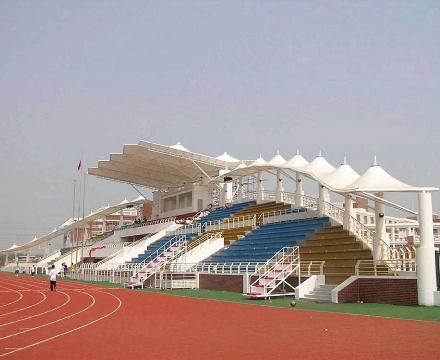Dapeng Town Industrial Park, Tongshan District, Xuzhou City, Jiangsu Province, China
It is necessary for the roof of the membrane structure building to have anti-noise function, especially in some sports field membrane structures, stadium membrane structures, stadium membrane structures, square membrane structures, exhibition hall membrane structures, etc. The realization of the anti-noise function of the membrane structure building is carried out by focusing on the acoustic quality of two aspects through the acoustic design of the membrane structure. First, how to shield the influence of external noise on the interior of the building; second, the influence of the interior contour of the building on the echo effect and reverberation time. The factors that need to be considered in noise and echo are completely different, but both must be considered at the same time, and the comprehensive quality of the building acoustic environment should be evaluated.

The echo time is proportional to the interior volume of the building and inversely proportional to the sound absorption rate of the interior surface. Good voice quality requires a short echo time, so as to avoid mutual interference between sound waves. This is generally not difficult for small conference rooms, but it is very difficult to effectively solve this problem in large closed building spaces, such as gymnasiums, indoor track and field, Aquatic center, stadium, etc.
According to the overall planning, function and economic budget of architectural design, choose the most cost-effective membrane design scheme:

First consider the orientation and location of the membrane structure in order to minimize noise penetration. In addition to the location of the building, the design of sound insulation should be considered to reduce common noise transmitted from the ground and isolate the noise source from the structure. Under normal circumstances, every time the distance between the sound source and the building is doubled, the noise is reduced by 6dB, while the use of bushes to shield the noise can only reduce the noise by 0.4dB, which is negligible.
Increasing the number of layers of the film, the thickness of the arrow control interlayer, and if necessary, attaching weight to the film layer are all available methods to improve the noise reduction effect. The connection technology of the membrane structure needs to be carefully considered to ensure its tightness and reduce the possibility of airborne noise penetrating through the gap. At the same time, it should be ensured that the thermal performance of the building should not be affected when these measures are taken.
As with most treatments of architectural acoustics, it is important to separate noise from facilities and other noise sources from conclusions. Careful design of interior acoustic surfaces is also important, as acoustic technology can help attenuate the effects of background noise in the interior.